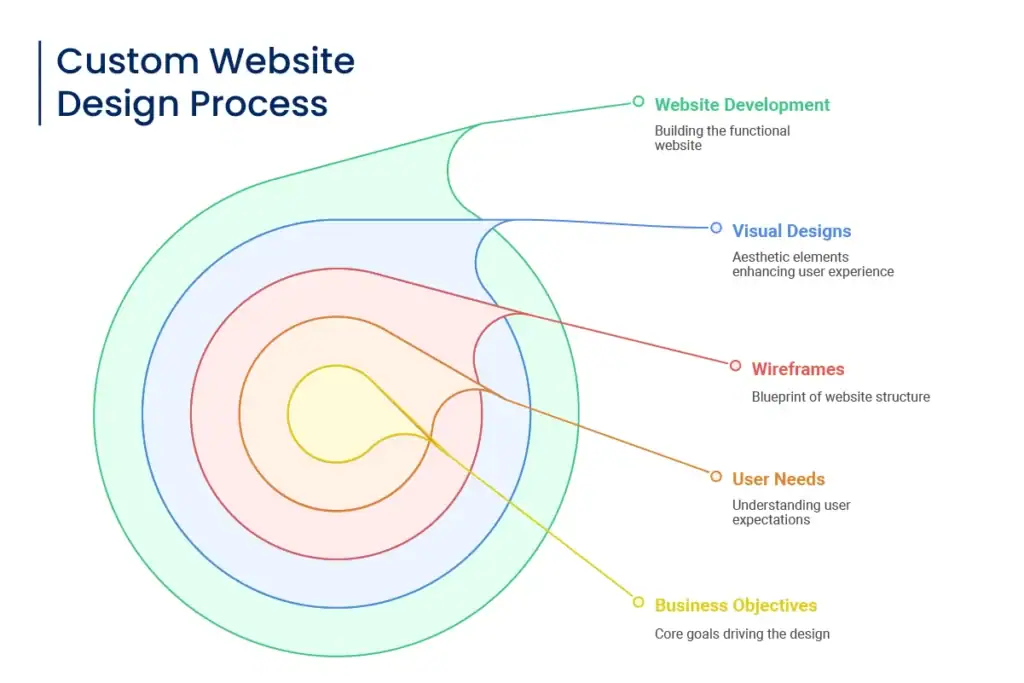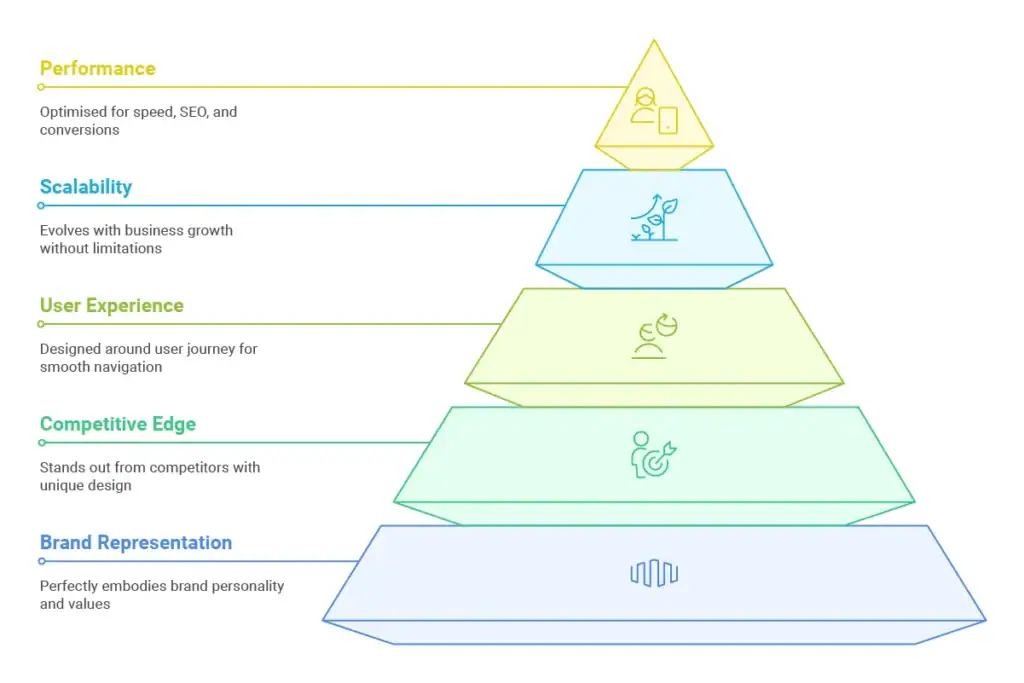Custom Design
Do you know why some sites are magnetic, attracting visitors and transforming them into loyal customers? It’s a secret that lies in custom website design, a tactical process that transcends looks to build a strong business asset that works around the clock for your brand.
Creating a website that accurately reflects your brand and connects with your target audience takes both technical prowess and creative flair. In contrast to template-based sites, custom designs provide infinite options for building something original that is distinct from the pack.
This service reveals the building blocks of bespoke custom website design, why it’s important for your business success, and a real-world framework to guide you through the process with success.

Custom website design is the act of designing a one-of-a-kind, purpose-designed website that’s specifically made to serve your business goals, brand, and user requirements. It’s the reverse of pre-fabricated templates or generic solutions.
At its foundation, bespoke web design starts with knowing your business objectives and user needs before writing a single line of code. It’s the process of developing wireframes, visual designs, and eventually building a fully operational website that’s uniquely yours—engineered to achieve particular results such as creating leads, selling goods, or establishing brand reputation.
The most significant distinction between template and custom websites is in their basis. Template websites begin with the foundation that already exists, which you modify to suit your content. Custom websites begin with your singular business needs and create solutions on top of them.

Your website is usually the first substantial contact prospective customers have with your company. Here’s why custom website design is worth investing in:

Custom design guarantees that your website ideally reflects your brand's personality, values, and differentiator, creating instant recognition and trust.
In markets where there are dozens of companies that have similar products and services, a bespoke website allows you to differentiate instead of fitting in with others who are using the same templates.
Bespoke websites can be tailored specifically to your users' journey, eliminating friction points and directing visitors towards desired actions that are profitable for your company.
As your enterprise expands, a custom site can grow with it without hitting the constraints usually present in template packages.
Sites that are built from scratch can be optimized for speed, search engines, and conversions outright, instead of having to be retrofitted with workarounds to make a template work.
Although it costs more upfront, custom sites tend to need less maintenance and fine-tuning over time, lowering long-term costs of operation.
Building a successful custom website requires a number of interdependent elements. Below is a framework that deconstructs the most important elements:

The starting point of any successful custom website is having a clear articulation of your business goals, target market, and key performance indicators (KPIs). This step entails:
Without this strategic framework, the most beautiful website will not be successful from a business perspective. A content marketing strategy that incorporates these goals guarantees your website content directly addresses the needs of your audience.
After you’ve developed your strategic framework, the discovery process translates business goals into design needs:
This stage establishes the blueprint for your project, establishing clear expectations and deliverables. It’s where you decide what technology stack will suit your requirements best and what content should be prioritized.
The user experience (UX) and user interface (UI) design process is where your site starts to form:
This phase is concerned with how users will engage with your site, ensuring the design meets their needs and directs them toward your business goals. Good website maintenance starts with good UX/UI choices that establish a strong foundation.
Visual design turns wireframes into engaging designs that reinforce your brand identity:
This phase brings your brand to life on the web while upholding accessibility and usability criteria. A solid brand identity design should naturally carry over onto your website’s visual voice.
At development, designs are converted into operational code:
This stage needs experienced developers that can retain design integrity while creating a technically solid website. The appropriate website design and development partner will ensure both form and function beautifully balanced.
Search engine optimization needs to be incorporated in your bespoke site from the outset:
This allows your lovely website to be found by your intended market. Employing the services of an established SEO company in India can guide you through this maze.
The launch is only the start of your website’s life cycle:
Building a successful custom website requires a number of interdependent elements. Below is a framework that deconstructs the most important elements:
Choosing the appropriate tools will make or break your custom website design project:

Assumption-driven design instead of designing from real user needs results in low engagement and high bounce rates. Always begin with solid user research.
Comprehensive testing across browsers, devices, and usage scenarios must be done prior to launch to avoid humiliating mistakes and subpar user experiences.
Gorgeous designs that annoy users will fail in the end. Balance beauty with usability and performance.
Intricate navigation hierarchies confuse users and boost abandonment. Make navigation simple and easy to use.
With over half of all web traffic coming from mobile users, not optimising for mobile devices is a fatal flaw.
Slow websites scare away visitors and damage search rankings. Optimize images, reduce code, and employ caching methods to have fast load speeds.
Your site is not an electronic brochure—it’s a dynamic business asset that’s capable of fueling growth, establishing brand value, and forging meaningful relationships with your customers. Templates may appear on the surface to be the cost-saving way to go or even free, but they really restrict your ability to be different or connect with your desired audience.
Custom web design, when done strategically, provides a uniquely bespoke digital experience that accurately reflects your brand and well-serves your business objectives. It brings together artistic design and technical prowess to produce something that’s not only visually striking but also functional strength.
The process costs money—and time and effort too—but the end result can take your online presence from good to great. In a business world where digital experiences are becoming more critical to success, bespoke custom website design is no longer a nicety; it’s becoming an essential for brands that want to prosper.
If you want to take your online presence to the next level with sophisticated custom website design, our crew of experts can assist you in realizing your dream. We unite creativity with technical know-how to design websites that not only look stunning—also excel technologically.

Enter your email to get instant access